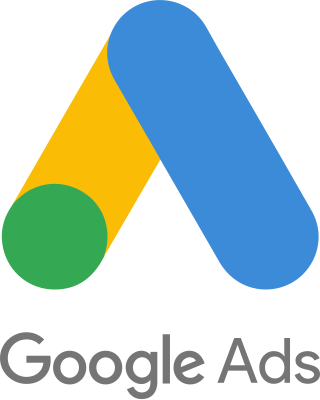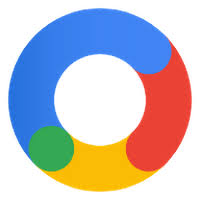Digital display advertising is online graphic advertising through banners, text, images, video, and audio. The main purpose of digital display advertising is to post company ads on third-party websites. A display ad is usually interactive, which allows brands and advertisers to engage deeper with the users. A display ad can also be a companion ad for a non-clickable video ad.
Google AdSense is a program run by Google through which website publishers in the Google Network of content sites serve text, images, video, or interactive media advertisements that are targeted to the site content and audience. These advertisements are administered, sorted, and maintained by Google. They can generate revenue on either a per-click or per-impression basis. Google beta-tested a cost-per-action service, but discontinued it in October 2008 in favor of a DoubleClick offering. In Q1 2014, Google earned US$3.4 billion, or 22% of total revenue, through Google AdSense. AdSense is a participant in the AdChoices program, so AdSense ads typically include the triangle-shaped AdChoices icon. This program also operates on HTTP cookies. In 2021, over 38.3 million websites use AdSense.
DoubleClick Inc. was an American advertisement company that developed and provided Internet ad serving services from 1995 until its acquisition by Google in March 2008. DoubleClick offered technology products and services that were sold primarily to advertising agencies and mass media, serving businesses like Microsoft, General Motors, Coca-Cola, Motorola, L'Oréal, Palm, Inc., Apple Inc., Visa Inc., Nike, Inc., and Carlsberg Group. The company's main product line was known as DART, which was intended to increase the purchasing efficiency of advertisers and minimize unsold inventory for publishers.

Google Ads is an online advertising platform developed by Google, where advertisers bid to display brief advertisements, service offerings, product listings, and videos to web users. It can place ads in the results of search engines like Google Search, mobile apps, videos, and on non-search websites. Services are offered under a pay-per-click (PPC) pricing model.
Pay-per-click (PPC) is an internet advertising model used to drive traffic to websites, in which an advertiser pays a publisher when the ad is clicked.
Ad serving describes the technology and service that places advertisements on Web sites, mobile apps, and Connected TVs. Ad serving technology companies provide software to Web sites and advertisers to serve ads, count them, choose the ads that will make the Web site or advertiser the most money, and monitor the progress of different advertising campaigns. Ad servers are divided into two types—publisher ad servers and advertiser ad servers.
An online advertising network or ad network is a company that connects advertisers to websites that want to host advertisements. The key function of an ad network is an aggregation of ad supply from publishers and matching it with advertiser's demand. The phrase "ad network" by itself is media-neutral in the sense that there can be a "Television Ad Network" or a "Print Ad Network", but is increasingly used to mean "online ad network" as the effect of aggregation of publisher ad space and sale to advertisers is most commonly seen in the online space. The fundamental difference between traditional media ad networks and online ad networks is that online ad networks use a central ad server to deliver advertisements to consumers, which enables targeting, tracking and reporting of impressions in ways not possible with analog media alternatives.
Cost per action (CPA), also sometimes misconstrued in marketing environments as cost per acquisition, is an online advertising measurement and pricing model referring to a specified action, for example, a sale, click, or form submit.
Online advertising, also known as online marketing, Internet advertising, digital advertising or web advertising, is a form of marketing and advertising which uses the Internet to promote products and services to audiences and platform users. Online advertising includes email marketing, search engine marketing (SEM), social media marketing, many types of display advertising, and mobile advertising. Advertisements are increasingly being delivered via automated software systems operating across multiple websites, media services and platforms, known as programmatic advertising.
Cost per mille (CPM), also called cost per thousand (CPT), is a commonly-used measurement in advertising. It is the cost an advertiser pays for one thousand views or impressions of an advertisement. Radio, television, newspaper, magazine, out-of-home advertising, and online advertising can be purchased on the basis of exposing the ad to one thousand viewers or listeners. It is used in marketing as a benchmarking metric to calculate the relative cost of an advertising campaign or an ad message in a given medium.
Microsoft Advertising is an online advertising platform developed by Microsoft that provides pay per click advertising on the Bing, Yahoo!, and DuckDuckGo search engines, as well as on other websites, mobile apps, and videos.
In Internet marketing, search advertising is a method of placing online advertisements on web pages that show results from search engine queries. Through the same search-engine advertising services, ads can also be placed on Web pages with other published content.
Website monetization is the process of converting existing traffic being sent to a particular website into revenue. The most popular ways of monetizing a website are by implementing pay per click (PPC) and cost per impression (CPI/CPM) advertising. Various ad networks facilitate a webmaster in placing advertisements on pages of the website to benefit from the traffic the site is experiencing.

Targeted advertising is a form of advertising, including online advertising, that is directed towards an audience with certain traits, based on the product or person the advertiser is promoting. These traits can either be demographic with a focus on race, economic status, sex, age, generation, level of education, income level, and employment, or psychographic focused on the consumer values, personality, attitude, opinion, lifestyle and interest. This focus can also entail behavioral variables, such as browser history, purchase history, and other recent online activities. The process of algorithm targeting eliminates waste.
A supply-side platform (SSP) or sell-side platform is a technology platform to enable web publishers and digital out-of-home (DOOH) media owners to manage their advertising inventory, fill it with ads, and receive revenue. Many of the larger web publishers of the world use a supply-side platform to automate and optimize the selling of their online media space.
A demand-side platform (DSP) is a concept that combines various software solutions for advertisers to automate the process of buying and selling ad impressions in real time.
Real-time bidding (RTB) is a means by which advertising inventory is bought and sold on a per-impression basis, via instantaneous programmatic auction, similar to financial markets. With real-time bidding, advertising buyers bid on an impression and, if the bid is won, the buyer's ad is instantly displayed on the publisher's site. Real-time bidding lets advertisers manage and optimize ads from multiple ad-networks, allowing them to create and launch advertising campaigns, prioritize networks, and allocate percentages of unsold inventory, known as backfill.
iSocket is a technology platform designed to simplify guaranteed media sales. It is notable as the first company to facilitate the programmatic buying of direct, guaranteed display ad inventory.

Google Marketing Platform is an online advertising and analytics platform developed by Google and launched on July 24, 2018. It unifies DoubleClick's advertising services and Google's own advertising and analytics services. Google Marketing Platform is mainly used by big advertisers to buy ads on the Internet.
The Trade Desk, Inc. is an American multinational technology company that specializes in real-time programmatic marketing automation technologies, products, and services, designed to personalize digital content delivery to users.


